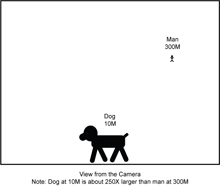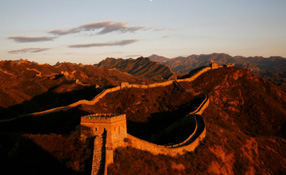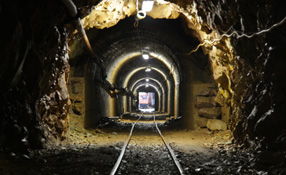 Video analytics enables security teams to take action as soon as incidents occur |
Video analytics can boost security efforts by automatically alerting personnel to take action when a security event occurs. Intelligent sensors never tire, can cover large distances and “see” what the eye would miss, even in absolute darkness. Based on such intelligent analytics, people can make smart decisions when actual violations happen. John Romanowich, CEO of SightLogix believes that the key to effective application of video analytics in the outdoors is to use best practices in equipment selection and installation, as he explains below.
Reducing outdoor security false alarms
Outdoor surveillance cameras, which operate by detecting movement within their field of view, must contend with an environment that is constantly changing. These cameras are usually mounted high on poles that shake due to slight wind or vibration. Clouds create moving shadows on the ground. Trees and leaves flap in the breeze, creating more movement. Adding in rain, snow and dust, such a dynamic environment can cause an abundance of nuisance alarms that quickly overwhelm security efforts.
Discerning legitimate targets from natural motion is a significant task considering the amount of data that a surveillance camera needs to analyze over a large outdoor scene spanning hundreds of meters.
Doing so is best accomplished with security cameras that bring a high degree of video processing to analyze the scene. When such processing capacity is placed directly within the camera, 100 percent of the raw scene data becomes available to the video analytics system, making it possible to examine the full visual detail of every video frame, eliminating - at the source - all the impediments that would otherwise trigger false security alarms.
 View large image Figure 1: Intelligent surveillance camera with multiple processors |
Figure 1 illustrates this approach, which requires multiple processors embedded into the surveillance camera. This allows the camera to electronically stabilise the image to eliminate camera motion, dynamically correct for changing lighting, fog, rain, snow and sandstorms. It also helps to eliminate motion from small animals, blowing debris, trees moving in the breeze and reflections from water, while increasing the probability that pedestrians or other objects of concern will be detected.
Applying video analysis outside the security cameraAlternatively, systems that employ video content analysis outside of the camera must compress the scene data for network transmission, removing most of the finer scene details. In such systems, often as much as 99% of the data is removed. In the outdoors, the loss of so much detail proportionally degrades the ability to accurately detect targets. Such systems also lack the necessary image processing to compensate for the outdoor variables.
Integrating the imager directly with the video analytics system- inside the camera enclosure, with a high degree of processing the edge - is the cornerstone of a smart camera's ability to accurately detect targets in the outdoor environment.
Pinpointing security violations at hey unfold
 |
| Geo registration enable security breaches to be located as they happen |
The goal for security is to maintain awareness of risks and quickly obtain reliable information about the place and nature of an intrusion. Intelligent surveillance cameras can meet these goals when they are "geo-registered." Geo-registration, which means that the camera's field of view (FOV) maps the GPS coordinates of all points in the landscape under surveillance, unlocks key functional benefits of an intelligent video surveillance system such as situational awareness and automatic PTZ direction.
Specifically, geo-registration enables a three dimensional capability to ascertain the size of all moving objects in the field of view for making accurate security determinations. This is particularly important over expansive areas, where small objects close to the camera will appear substantially larger than a person standing off in the distance, as illustrated in Figure 2.
In the following example, a dog at 10 meters from the camera is approximately 250 times larger than a man appears to be at 300 meters. Cameras that lack geo-registration will interpret that the dog is the larger object and send an alert, while ignoring the person in the distance.
 View larger image Figure 2: Depth of perception with Geo-registration |
Conversely, surveillance cameras which employ geo-registration will detect human-sized objects anywhere within their field of view, whether near or far from the camera, and ignore small animals, blowing trash or debris.
Perimeter security design and addressing blind spots under the camera
Many outdoor surveillance designs will narrow a security camera's field of view to increase the camera's detection distance in an effort to decrease costs. Doing so will extend the "blind" spot under the camera leaving gaps in coverage that may extend great distances.
The example shown in Figure 3 depicts two perimeter security designs using cameras mounted at twenty feet off the ground with a seven degree horizontal field of view. In the top design, the coverage range of "Camera 1" stops near the base of the pole of "Camera 2", leaving approximately 60 meters of unprotected area where intruders can enter undetected.
 View larger image Figure 3: Addressing bling spots |
Determining a camera's true detection range
Understanding a camera's true automated detection range also addresses potential gaps in perimeter security design. This is best accomplished by measuring the camera's detection range when a person walks directly towards the camera, rather than across path of the camera's field of view, as shown in Figure 4.
 View larger image Figure 4: Determining a camera's true detection range |
Walking across a camera's view creates a lot of motion, making it easy for the camera to detect the object. On the other hand, when a person moves directly towards a camera, the camera's detection is limited mostly to leg motion, which is a much smaller variation and more difficult to detect at greater distances.
Addressing false alerts from changing lighting conditions
The use of From/To rules can be effective where changing lighting conditions such as headlights cause nuisance alarms. Unlike "trip-wire" rules, which are triggered when a detected object crosses an established line in the camera's field of view, From/To rules use spatial characteristics such as size, speed, bearing and persistence.
Deploying video analytic systems for outdoor areas and site perimeters can be cost-effective and highly accurate |
From/To rules are invoked when an object that maintains persistent tracking and represents a specific size moves from one region of the scene (the "From" zone) and enters the other area of the scene (the "To" zone). In this case, the camera will determine that the detected object represents a credible threat and send an alert. This is accomplished with the combination of a specific size filter along with a From/To zone to greatly reduce the likelihood of headlights causing a nuisance alert with a visible camera.
The use of thermal imagers represents another viable approach for solving lighting challenges. These include surveillance applications over water, where reflections would cause difficulty for visible cameras, or for surveillance applications that take place in total darkness.
Protective enclosures for outdoor surveillance cameras
Enclosing an indoor surveillance camera in a protective enclosure might protect against some conditions such as rain, but it may not protect against humidity, sand, and extreme temperatures. In the outdoors, normal expansion and contraction occur due to thermal changes throughout the day, allowing grit, dust or humidity to possibly enter the security camera housing and impact the electronics, reducing the service life of the camera.
To address this, choose cameras which have been sealed and nitrogen-pressurized to keep weather from entering into the enclosure, even in extreme conditions. For example, some cameras can operate in environments that range from the Canada Oil Sands to the Middle East due to their sealed enclosures and thermal dynamic packaging to manage heat from the processors.
Containing security costs
The same multi-processing power that gives video analytics-enabled cameras their ability to accurately detect targets often gives them extended range and area coverage - in many cases three times as much distance or area as other cameras. As a result, there is a proportionate project cost savings - typically to the order of 50% - from the elimination of the extra cameras and poles, construction, trenching, power and network connectivity that would have otherwise been required.
Conclusion
Deploying video analytic systems for outdoor areas and site perimeters can be surprisingly cost-effective while also trustworthy, secure and highly accurate. By applying a best practices approach, organizations can meet outdoor security objectives with much higher levels of accountability and cost effectiveness.
 | John Romanowich CEO SightLogix |





















